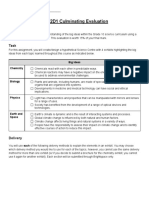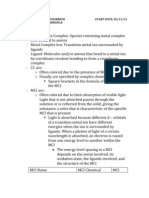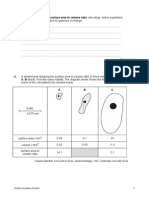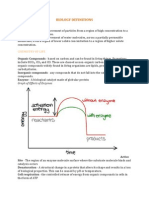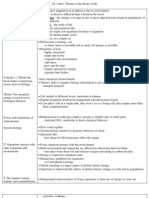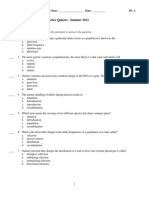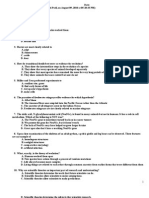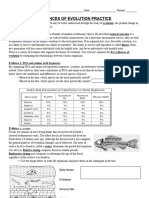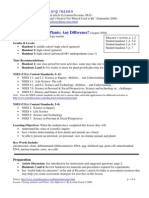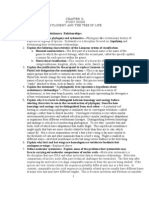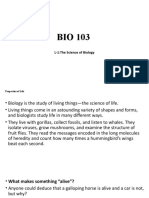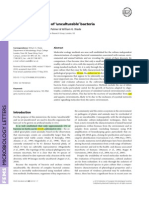Chapter 1: Biology: Exploring Life
Chapter 1: Biology: Exploring Life
Uploaded by
Thalia LauCopyright:
Available Formats
Chapter 1: Biology: Exploring Life
Chapter 1: Biology: Exploring Life
Uploaded by
Thalia LauOriginal Description:
Original Title
Copyright
Available Formats
Share this document
Read this document in other languages
Did you find this document useful?
Is this content inappropriate?
Copyright:
Available Formats
Chapter 1: Biology: Exploring Life
Chapter 1: Biology: Exploring Life
Uploaded by
Thalia LauCopyright:
Available Formats
CHAPTER 1: BIOLOGY: EXPLORING
LIFE
1.1 All forms of life share common properties
Common Properties
1.
2.
3.
4.
5.
6.
7.
Order
Reproduction
Growth and Development
Energy Processing
Response to the Environment
Regulation
Evolutionary Adaptation
Points:
o Living cells are the basis of the complex organization
of life.
1.2 In lifes hierarchy of organization, new properties emerge at each level
1. Biosphere
2. Ecosystem all of the organisms living in a particular area with
physical components
3. Community the entire array of organisms in an ecosystem
4. Population all the individuals of a particular species living in
an area
5. Organism individual living thing
6. Organ System consists of several organs that cooperate in a
specific function
7. Organ made up of several different tissues
8. Cell the fundamental unit of life
9. Organelle a membrane-enclosed structure that performs a
specific function in a cell
10.
Molecule is a cluster of small chemical units called
atoms
Points:
o DNA (deoxyribonucleic acid) the molecule of
inheritance
o Each unique form of life is called a species.
o The emergent properties of each level result from the
specific arrangement and interaction of its parts.
1.3 Cells are the structural and functional units of life
The ability of cells to give rise to new cells is the basis for all
reproduction.
Two basic types of cells:
o Prokaryotic cells - sole inhabitants for about the first
1.5 billion years of life on Earth
o Eukaryotic cells evolved about 2.1 billion years ago
System a combination of components that forms a more complex
organization
Examples of biological systems are cells, organisms, and
ecosystems.
Systems and their emergent properties are not unique to life.
Systems biology constructing models for the dynamic behavior
of whole systems based on studying the interactions among the
parts.
1.4 Organisms interact with their environment, exchanging matter and
energy
Two major processes of the dynamics of ecosystems:
o Recycling of chemical nutrients
o Flow of energy
An ecosystem gains and loses energy constantly.
1.5 The unity of life is based on DNA and a common genetic code
DNA the chemical substance of genes
Genes the units of inheritance that transmit information from
parents to offspring
Each DNA molecule is made up of two long chains coiled together
into what is called a double helix.
The DNA of genes provides the blueprints for making proteins.
Proteins serve as the tools that actually build and maintain the cell
and carry out its activities.
1.6 The diversity of life can be arranged into three domains
Dimensions of Biology
o Vertical Dimension size scale that stretches from
molecules to the biosphere
o Horizontal Dimension spanning across the great diversity
of organisms
Diversity is a hallmark of life.
Biologists have so far identified and named about 1.8 million
species.
Estimates of the total number of species range from 10 million to
over 100 million.
The Three Domains of Life
1. Bacteria are the most diverse and widespread prokaryotes.
2. Archaea live in Earths extreme environments
3. Eukarya organisms with eukaryotic cells
a. Protists diverse collection of mostly single-celled
organisms and some relatively simple multicellular
relatives
The other three groups within Eukarya contain multi-cellular
eukaryotes and are distinguished partly by their modes of
nutrition.
b.
Plantae produce their own food by photosynthesis
c. Fungi decompose the remains of dead organisms and
organic wastes and absorb the nutrients
d.
Animalia obtain food by ingestion
1.7 Evolution explains the unity and diversity of life
The history of life is documented by fossils.
In November 1859, the English naturalist Charles Darwin
published On the Origin of Species by Means of Natural
Selection.
Evolution
o The idea that species living today are descendants of
ancestral species.
o The core theme that makes sense of everything we know and
learn about life
o Darwin called his evolutionary theory descent with
modification.
Natural selection the mechanism Darwin proposed for evolution.
o Those individuals with heritable traits best suited to the
environment are more likely to survive and reproduce than
less well-suited individuals.
o The result of natural selection is evolutionary adaptation,
the accumulation of favorable traits in a population over time.
o Numerous small changes in populations caused by natural
selection could eventually lead to major alterations of species.
1.8 Scientific inquiry is used to ask and answer questions about nature
Science
o Derived from a Latin verb meaning to know
o A way of knowing an approach to understanding the natural
world
o Involves the process of inquiry a search for information,
explanations, and answers to specific questions
Scientific Inquiry
o Making observations
o Forming hypotheses
o Testing predictions
Types of Data
o Qualitative
o Quantitative
Inductive Reasoning derives generalization from a large number
of specific observations
Deductive Reasoning the type of logic used to come up with ways
to test hypotheses, the logic flows from general premises to specific
results we should expect if the premises are true
Hypothesis a proposed explanation for a set of observations
A scientific theory is much broader in scope than a hypothesis.
1.9 Scientists form and test hypotheses and share their results
A hypothesis must be testable and falsifiable.
A hypothesis gains credibility by surviving multiple attempts to
falsify it, while alternative hypotheses are eliminated by testing
Experimental and control groups differ only in the one factor the
experiment is designed to test.
Science is a social activity.
1.10 Biology, technology, and society are connected in important ways
The goal of science is to understand natural phenomena.
The goal of technology is to apply scientific knowledge for some
specific purpose.
Scientists discoveries; engineers inventions
1.11 Evolution is connected to our everyday lives
Biologists now recognize that differences in DNA among individuals,
populations, and species reflect the patterns of evolutionary
change.
The recognition that DNA differs between people has led to the use
of DNA tests to identify individuals.
Evolution teaches us that the environment is a powerful selective
force for traits that best adapt populations to their environment.
Evolutionary theory can help us be more judicious in our use of
antibiotics and pesticides and help us develop strategies for
conservation efforts.
You might also like
- Summative Assessement Criterion ADocument6 pagesSummative Assessement Criterion Aapi-484776271100% (1)
- SNC2D Culminating - Science Centre ExhibitsDocument4 pagesSNC2D Culminating - Science Centre ExhibitsApple100% (1)
- Transpiration POGIL Answer KeyDocument8 pagesTranspiration POGIL Answer KeyJade Tapper50% (2)
- Tracking The DragonDocument81 pagesTracking The DragonZorion80% (5)
- Zoology Notes 1Document9 pagesZoology Notes 1Alvarez, Chesna LoiseNo ratings yet
- ANIMAL CELLS AND TISSUES Lecture Notes PDFDocument17 pagesANIMAL CELLS AND TISSUES Lecture Notes PDFAnonymous HXLczq383% (6)
- Lab 12 - Chemical Equilibrium & Le Chatelier's Principle PrelabDocument4 pagesLab 12 - Chemical Equilibrium & Le Chatelier's Principle PrelabOmowunmi OdutolaNo ratings yet
- Allergy Article WorksheetDocument3 pagesAllergy Article Worksheetapi-299996815100% (3)
- Bio Cheat Sheet MasterDocument7 pagesBio Cheat Sheet MasterChris_Barber0986% (7)
- SA To Vol Ratio ALONG WithDocument7 pagesSA To Vol Ratio ALONG WithJames SmithNo ratings yet
- Biology DefinitionsDocument6 pagesBiology DefinitionsSixtine MorinNo ratings yet
- Cellular Ultrastructure: Eukaryotic CellsDocument9 pagesCellular Ultrastructure: Eukaryotic CellsPiriyatharshini RamanathNo ratings yet
- 20 Lecture PresentationDocument82 pages20 Lecture PresentationMaja Torlo100% (1)
- Evolution Review Packet Key EditableDocument4 pagesEvolution Review Packet Key EditableMiljoy Delegado100% (1)
- Chapter 4 A Tour of The CellDocument12 pagesChapter 4 A Tour of The Cellhuy luongNo ratings yet
- General Biology Mid Exam Summary Semester OneDocument26 pagesGeneral Biology Mid Exam Summary Semester OneDeborah Shirleen100% (1)
- Biol-111 - Mendelian Genetics WorksheetDocument10 pagesBiol-111 - Mendelian Genetics WorksheetKing Josh100% (1)
- Review Questions For Genetics and Heredity TestDocument6 pagesReview Questions For Genetics and Heredity TestLes Chiens100% (1)
- CH 1 Themes in The Study of LifeDocument4 pagesCH 1 Themes in The Study of Lifewil7verNo ratings yet
- Grade 11 Biology Genetics TestDocument3 pagesGrade 11 Biology Genetics TestValerieNo ratings yet
- Cladogram WsDocument4 pagesCladogram Wsjeffery thomasNo ratings yet
- Cells & Cell Organelles: Doing Life's WorkDocument38 pagesCells & Cell Organelles: Doing Life's WorkLawrence RayappenNo ratings yet
- Evolution and Natural SelectionDocument22 pagesEvolution and Natural SelectionmalikNo ratings yet
- BIO 127 General Microbiology:: Course Description and ObjectivesDocument24 pagesBIO 127 General Microbiology:: Course Description and Objectivescheramae ancesNo ratings yet
- Chapter 3 The Molecules of CellsDocument5 pagesChapter 3 The Molecules of Cellsmzunl25476No ratings yet
- Teacher Preparation Notes For Genetics and Genetics SupplementDocument16 pagesTeacher Preparation Notes For Genetics and Genetics SupplementMary Ann DimacaliNo ratings yet
- Edible Cell MakingDocument4 pagesEdible Cell MakingThefani Maezel Lofamia100% (1)
- Chapter 11 Biology TestDocument8 pagesChapter 11 Biology Testmohamad aliNo ratings yet
- Investigating Inherited TraitsDocument12 pagesInvestigating Inherited TraitsNoora AtariNo ratings yet
- Miller and Harley Zoology 11ed Ch02Document50 pagesMiller and Harley Zoology 11ed Ch02KEANNA RUBIANo ratings yet
- Active and Passive Transport RhsDocument25 pagesActive and Passive Transport Rhswaqas_xsNo ratings yet
- Cell Organelles ReviewDocument5 pagesCell Organelles ReviewvictoriaNo ratings yet
- Evolution Test Review KeyDocument5 pagesEvolution Test Review Keyapi-242868690No ratings yet
- Mendels Peas WorksheetDocument4 pagesMendels Peas WorksheetLouis Fetilo FabunanNo ratings yet
- Evolution 2010 Aug09 172833Document42 pagesEvolution 2010 Aug09 172833Aditi PatilNo ratings yet
- Cell Structure and Processes Practice Worksheet: Name: Pidlaoan, Coleen LDocument5 pagesCell Structure and Processes Practice Worksheet: Name: Pidlaoan, Coleen LColeenNo ratings yet
- Mendelian Principles - Work Sheet 1Document8 pagesMendelian Principles - Work Sheet 1Carlos FrancoNo ratings yet
- Study GuideDocument4 pagesStudy GuideJay DansNo ratings yet
- Kami Export - CellStructureSEDocument3 pagesKami Export - CellStructureSEDohnovan RankinsNo ratings yet
- Cell TheoryDocument18 pagesCell TheoryAika NaNo ratings yet
- Introduction To Genetics PPT by EasybiologyclassDocument23 pagesIntroduction To Genetics PPT by EasybiologyclassTamal Acharya100% (2)
- Cell and Molecular BiologyDocument18 pagesCell and Molecular BiologyHizzei Caballero100% (1)
- 2.4.1 Cell WallDocument17 pages2.4.1 Cell WallSyahirah SyerryNo ratings yet
- Classification and Taxonomy Guided NotesDocument4 pagesClassification and Taxonomy Guided Notesapi-375285021No ratings yet
- Evidences of EvolutionDocument8 pagesEvidences of EvolutionJazzy AndersonNo ratings yet
- Botany SyllabusDocument34 pagesBotany SyllabusVivek Ananth R P100% (1)
- Cell Organelle Review WorksheetDocument4 pagesCell Organelle Review WorksheetMae SilogNo ratings yet
- Plant and Animal TissuesDocument9 pagesPlant and Animal TissuesfranciscocyrilleNo ratings yet
- CloningDocument6 pagesCloningkikkabuttigieg1466No ratings yet
- Names: Section: Date:: Animal Cell ColoringDocument2 pagesNames: Section: Date:: Animal Cell ColoringKimoi1986No ratings yet
- Cellular Respiration 1Document28 pagesCellular Respiration 1Maria Flor PabeloniaNo ratings yet
- Lab Report #1 BiologyDocument3 pagesLab Report #1 BiologyCharles Maclean100% (1)
- Intro To EcologyDocument44 pagesIntro To EcologyJinky AydallaNo ratings yet
- Prokaryotic and Eukaryotic CellsDocument31 pagesProkaryotic and Eukaryotic CellsKomalesh TheeranNo ratings yet
- 12 Cellular Communication-SDocument5 pages12 Cellular Communication-SadaNo ratings yet
- Worksheets With AnswersDocument10 pagesWorksheets With Answersjainnah100% (1)
- Chapter1-Matter and MeasurementsDocument19 pagesChapter1-Matter and MeasurementsToman Chi To Lam100% (1)
- Characteristics of Living ThingsDocument31 pagesCharacteristics of Living ThingsOscar DamianiNo ratings yet
- Introduction To ZoologyDocument51 pagesIntroduction To Zoologyirish x100% (1)
- Cladograms and Phylogenic TreesDocument5 pagesCladograms and Phylogenic TreesRachel WNo ratings yet
- Gene Expression and Regulation: Ap BiologyDocument16 pagesGene Expression and Regulation: Ap BiologyFb EyeNo ratings yet
- Cell Composition, Structures and Cell As ReactorsDocument10 pagesCell Composition, Structures and Cell As ReactorsFirdaus Asha'riNo ratings yet
- Animal and Plant Cell PartsDocument5 pagesAnimal and Plant Cell PartsJess MCDNo ratings yet
- Allele Frequency LabDocument1 pageAllele Frequency Labjmunozbio@yahoo.com100% (1)
- Bio 107 Ch1 NotesDocument9 pagesBio 107 Ch1 Notesgjoceline95No ratings yet
- SHS - LAS - Earth - Life Science - MELC - 2 - Q2 - Week-2 - New - RemovedDocument4 pagesSHS - LAS - Earth - Life Science - MELC - 2 - Q2 - Week-2 - New - RemovedNini VillezaNo ratings yet
- Madrasatul Anwar, Block 7, Gulshan Iqbal, KarachiDocument3 pagesMadrasatul Anwar, Block 7, Gulshan Iqbal, KarachimunawarNo ratings yet
- Chapter 26 Study GuideDocument4 pagesChapter 26 Study GuideBen ReebsNo ratings yet
- OECD LEGAL 0225 enDocument7 pagesOECD LEGAL 0225 enMinseong LeeNo ratings yet
- Biology CH 7 Practice TestDocument6 pagesBiology CH 7 Practice Testvaleria100% (2)
- Origins of Life: A D D S C DDocument23 pagesOrigins of Life: A D D S C DjonasgoNo ratings yet
- Earth Scie 22Document26 pagesEarth Scie 22HayaradjNo ratings yet
- Slo Science Grade 7 2016-2017Document14 pagesSlo Science Grade 7 2016-2017api-375209006No ratings yet
- Bio 103-L1Document24 pagesBio 103-L1Nahid Sagar 1812889042No ratings yet
- Intro To MicrobiologyDocument31 pagesIntro To MicrobiologyLyka Durian LamosteNo ratings yet
- A Decade of Progress and Turning Points in The Understanding of Bio-Improved Soils: A ReviewDocument15 pagesA Decade of Progress and Turning Points in The Understanding of Bio-Improved Soils: A ReviewGita KhaerunnisaNo ratings yet
- Strategies For Culture of Unculturable BacteriaDocument7 pagesStrategies For Culture of Unculturable BacteriaEd M. K-zhan NözNo ratings yet
- Law246 Test 4Document4 pagesLaw246 Test 4NAVY DecremNo ratings yet
- Q1 GenBio1 SLKWeek2 EditDocument21 pagesQ1 GenBio1 SLKWeek2 EditInele Ellia AgRe100% (1)
- IUMS2014, ProceedingDocument1,487 pagesIUMS2014, Proceedingamir-scribdNo ratings yet
- Introductory Biochemistry 1614727331. PrintDocument477 pagesIntroductory Biochemistry 1614727331. PrintA.peace ChaukeNo ratings yet
- Sauce4 (STS)Document27 pagesSauce4 (STS)Darren GreNo ratings yet
- Tabaquero, Carlo T. BSED Filipino 1E-4Document16 pagesTabaquero, Carlo T. BSED Filipino 1E-4krysteen milloNo ratings yet
- Skripta-Plant Biology PDFDocument103 pagesSkripta-Plant Biology PDFVishnupriya Vijayaraghavan SrinivasanNo ratings yet
- SEMINAR REPORT TODAY 3 Almost Done 1Document21 pagesSEMINAR REPORT TODAY 3 Almost Done 1Afsal ShajiNo ratings yet
- Biology Cells and HuntDocument292 pagesBiology Cells and HuntSyed100% (1)
- SCIENCE 4 COT Carol B.Document7 pagesSCIENCE 4 COT Carol B.eloisa mae malitaoNo ratings yet
- Revision Notes For CBSE Class 11 Biology Chapter 1 - Free PDF DownloadDocument8 pagesRevision Notes For CBSE Class 11 Biology Chapter 1 - Free PDF DownloadRica NorcioNo ratings yet
- SBT 2173: Introduction To Microbiology: Dr. Elizabeth Mitaki Lesson 1Document30 pagesSBT 2173: Introduction To Microbiology: Dr. Elizabeth Mitaki Lesson 1Derrick kinyaNo ratings yet

